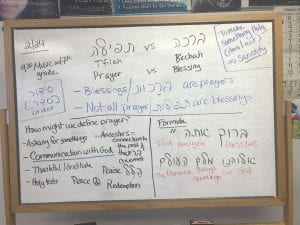We have been discussing the differences and similarities between a B’rachah (Blessing) and a T’filah (Prayer). The students discovered that all b’rachot (blessings) are t’filot (prayers), but not vice versa. Blessings can be defined by the Hebrew formula “Baruch Atah Adonai,” which sometimes continues, “Eloheinu Melech HaOlam…” or “Blessed are You, Adonai Our God, Ruler of the Universe…”. Some b’rachot also include the words for fulfilling a mitzvah or commandment: “Asher kid’shanu b’mitzvotav v’tzivanu…” which translates as “who hallows us with mitzvot, commanding us to…”. Continue reading
Category: Prayer
Haftarah Trope
Two weeks ago, we began our next big adventure in 6th grade, the cantillation of Haftarah. We started with a discussion about how Haftarah trope and Torah trope are similiar:
1. The names of each symbol are the same (Mercha, Tipcha etc.).
2. The family or clause groups are still the same (and their color-coding): Sof Pasuk, Etnachta, Katon, T’vir, R’vi-i and Segol.
3. Each trope symbols still functions as it did in Torah, as a M’chabeir (connector) or Mafsik (separator).
4. The location of the trope symbol, above or below a word, still indicates the word’s syllabic stress. Continue reading
Exploring Prayer Both Ancient and Modern
Through the winter we have been delving further into our Mishkan T’filah siddur (prayer book) in order to get to know more about t’filot or prayers. We began our discussion with a history lesson about the destruction of The Temple in Jerusalem and how this eventually led to the concept of a local synagogue, and the need to replace sacrifice with a different kind of devotion to G-d, prayer.
That led us to explore our prayers to see where each one came from. Continue reading
T’filah Project
Yesterday the students and I discussed our next assignment, the T’filah (Prayer) Project. This is a year-long project where each student in class has the opportunity to be a teacher for the day. They will research, practice, and present a prayer to the class in a creative and fun way. We discussed the assignment in detail and what each student’s responsibility will be. The entire assignment can be found here: https://marlaaviva.edublogs.org/tfilah-project/ Continue reading
Am I Awake
Throughout the year on Wednesdays we have focused on the T’filah Project – your students teaching the class the prayers of Seder Kriyat HaTorah through the concluding prayers of Aleinu and the Mourner’s Kaddish. On Sundays for the last month or so, we have approached prayer from a different angle, examining traditional prayers on the right-hand pages of the Siddur and then comparing and contrasting to the alternative prayers on the left-hand pages of the prayer book. The students have also had a chance to write their own prayers based on a given theme such as Hodaah (Thanksgiving), Ahavat Olam (G-d’s Everlasting Love), T’filat HaLev (Prayers of the Heart), and Mi Shebeirach (Prayers of Healing). Continue reading
